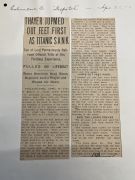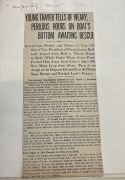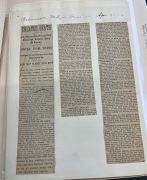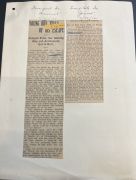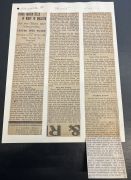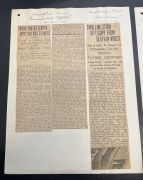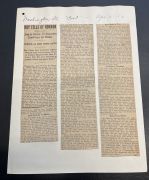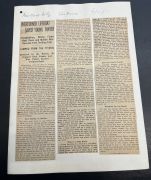John B. Thayer Titanic Memorial Collection: Difference between revisions
| (32 intermediate revisions by the same user not shown) | |||
| Line 1: | Line 1: | ||
The '''John B. Thayer memorial collection of the Sinking of the Titanic''' is an [https://franklin.library.upenn.edu/catalog/FRANKLIN_9976537653503681 archive] of first-hand accounts, family material, and memorialization efforts kept by the prominent, Philadelphia-based Thayer family from 1912 to 2012. The collection was started in memory of John Borland Thayer II (Sr.) who died during the sinking of the ocean liner’s maiden voyage. | The '''John B. Thayer memorial collection of the Sinking of the Titanic''' is an [https://franklin.library.upenn.edu/catalog/FRANKLIN_9976537653503681 archive] of first-hand accounts, family material, and memorialization efforts kept by the prominent, Philadelphia-based Thayer family from 1912 to 2012. The collection was started in memory of John Borland Thayer II (Sr.) who died during the sinking of the ocean liner’s maiden voyage. | ||
[[File: johnsr.jpg|right|thumb|John Borland Thayer Sr.]] | [[File: johnsr.jpg|right|thumb|John Borland Thayer Sr.]] | ||
Thayer’s wife, Marian Longstreth Morris Thayer, and son, John “Jack” Borland Thayer III (Jr.), survived the tragedy and created the collection. In 2014, the collection was gifted to the University of Pennsylvania's Kislak Center for Special Collections, Rare Books and Manuscripts by Jack Thayer's daughter, Pauline Thayer Maguire, and her husband, Robert Maguire. | Thayer’s wife, Marian Longstreth Morris Thayer, and son, John “Jack” Borland Thayer III (Jr.), survived the tragedy and created the collection. In 2014, the collection was gifted to the University of Pennsylvania's Kislak Center for Special Collections, Rare Books and Manuscripts by Jack Thayer's daughter, Pauline Thayer Maguire, and her husband, Robert Maguire. | ||
== History == | == History == | ||
[[File: johnjr.jpg||right|thumb|John "Jack" Borland Thayer Jr.]] | [[File: johnjr.jpg||right|thumb|John "Jack" Borland Thayer Jr.]] | ||
The Thayers were a prominent and wealthy family in the Philadelphia area at the turn of the 19th century. [https://en.wikipedia.org/wiki/John_B._Thayer John Borland Thayer Sr.] (1862-1912) was born in Philadelphia and attended the University of Pennsylvania. He was the Second Vice President of the Pennsylvania Railroad Company at the time of his death. He lived in Haverford, Pennsylvania with his wife, [https://en.wikipedia.org/wiki/Marian_Thayer Marian Thayer], (1872-1944) and their four children: [https://en.wikipedia.org/wiki/Jack_Thayer John “Jack” Borland Thayer Jr.] (1894-1945), Frederick Morris Thayer (1896-1956), Margaret Thayer (1898-1960), and Pauline Thayer (1901-1981). In 1912, John, Marion, and Jack traveled to Europe and boarded the RMS Titanic for their return to the United States. | The Thayers were a prominent and wealthy family in the Philadelphia area at the turn of the 19th century. [https://en.wikipedia.org/wiki/John_B._Thayer John Borland Thayer Sr.] (1862-1912) was born in Philadelphia and attended the University of Pennsylvania. He was the Second Vice President of the Pennsylvania Railroad Company at the time of his death. He lived in Haverford, Pennsylvania with his wife, [https://en.wikipedia.org/wiki/Marian_Thayer Marian Thayer], (1872-1944) and their four children: [https://en.wikipedia.org/wiki/Jack_Thayer John “Jack” Borland Thayer Jr.] (1894-1945), Frederick Morris Thayer (1896-1956), Margaret Thayer (1898-1960), and Pauline Thayer (1901-1981). In 1912, John, Marion, and Jack traveled to Europe and boarded the RMS Titanic for their return to the United States. | ||
[[File: marian.jpg|200px|left|thumb|Marian Longstreth Morris Thayer]] | [[File: marian.jpg|200px|left|thumb|Marian Longstreth Morris Thayer]] | ||
On the night of April 14, 1912, the Titanic disaster began. Separated from her husband and son by a large crowd, Marian boarded lifeboat 4. As the ship began to sink, 17-year-old Jack stood by the rail with passenger Milton Long, who he’d just met, said goodbye, and jumped feet first just before it split in half. He was pulled underwater by the suction of the sinking vessel, but found refuge on an overturned lifeboat and was eventually rescued by lifeboat 12. He was reunited with his mother on the RMS Carpathia. His father's body was never recovered. | On the night of April 14, 1912, the Titanic disaster began. Separated from her husband and son by a large crowd, Marian boarded lifeboat 4. As the ship began to sink, 17-year-old Jack stood by the rail with passenger Milton Long, who he’d just met, said goodbye, and jumped feet first just before it split in half. He was pulled underwater by the suction of the sinking vessel, but found refuge on an overturned lifeboat and was eventually rescued by lifeboat 12. He was reunited with his mother on the RMS Carpathia. His father's body was never recovered. <ref>John B. Thayer memorial collection of the Sinking of the Titanic, Kislak Center for Special Collections, Rare Books and Manuscripts, University of Pennsylvania, box 1, folder 3.</ref> | ||
Four years later, Jack graduated from the University of Pennsylvania, served as a captain in the United States Army in World War I, and began his career in banking. He married Lois Buchanan Cassatt in 1917 and had six children: Edward and John (who both enlisted in the armed forces during World War II), Lois, Julie, Pauline, and Alexander, who died a few days after his birth. Jack served as treasurer and, later, financial vice-president for the University of Pennsylvania from 1939 until his death by suicide in 1945 at the age of 50. Contributions to the depression Jack suffered from later in life were the deaths of his son, Edward, and mother, Marian. A bomber pilot during the war, Edward’s plane was shot down in 1943 and his body was never found. Marion died at her home in Haverford on April 14, 1944, the 32nd anniversary of the Titanic disaster, at the age of 72. | Four years later, Jack graduated from the University of Pennsylvania, served as a captain in the United States Army in World War I, and began his career in banking. He married Lois Buchanan Cassatt in 1917 and had six children: Edward and John (who both enlisted in the armed forces during World War II), Lois, Julie, Pauline, and Alexander, who died a few days after his birth. Jack served as treasurer and, later, financial vice-president for the University of Pennsylvania from 1939 until his death by suicide in 1945 at the age of 50. Contributions to the depression Jack suffered from later in life were the deaths of his son, Edward, and mother, Marian. A bomber pilot during the war, Edward’s plane was shot down in 1943 and his body was never found. Marion died at her home in Haverford on April 14, 1944, the 32nd anniversary of the Titanic disaster, at the age of 72. | ||
As a reader and researcher of the Thayer family’s history and memorial collection, I have adopted Astrid Rasch’s proposed strategy of anxious reading that subjects texts, specifically memoirs, to “critical scrutiny despite, and alongside, the empathy that we feel for our subjects…This entails acknowledging both the pain that the author has gone through and the traumatic experience of those represented, and at the same time examining the way in which that trauma is described and how it functions in the moral and political economy of the text in its context | As a reader and researcher of the Thayer family’s history and memorial collection, I have adopted Astrid Rasch’s proposed strategy of anxious reading that subjects texts, specifically memoirs, to “critical scrutiny despite, and alongside, the empathy that we feel for our subjects…This entails acknowledging both the pain that the author has gone through and the traumatic experience of those represented, and at the same time examining the way in which that trauma is described and how it functions in the moral and political economy of the text in its context." <ref name="Rasch">Rasch, Astrid. "Anxious Reading: Interrogating Selective Empathy in Trauma Memoirs." Auto/biography Studies, 2021, p.5</ref> This subscription to anxious reading has allowed me to sympathetically engage with this memorial collection and the Thayer family who, as victims of a random and cruel trauma, have continued to bear witness to extreme suffering, grief, and loss since 1912. As Jack recalls in an article for the Philadelphia ''Evening Bulletin'' in 1932, "the spectacle of nearly 1,500 people struggling in the ice-cold waters of the Atlantic, and the steady roar of their voices, which kept up for 15 or 20 minutes, is a memory that does not become dim, even after 20 years." <ref>John B. Thayer memorial collection of the Sinking of the Titanic, Kislak Center for Special Collections, Rare Books and Manuscripts, University of Pennsylvania, box 1, folder 4</ref> | ||
Alongside this sympathetic reading is a critical examination of the collection. Because the collection is largely composed of first-hand accounts of the traumatic sinking, I initially had some hesitancy about their accuracy. However, a 2003 study that evaluated the accuracy of archival eyewitness testimony from survivors of the Titanic disaster who witnessed the ship's final plunge indicates that most of the testimonies (15 eyewitnesses of 20) are consistent with forensic evidence that demonstrates that the Titanic was breaking apart while it was still on the ocean's surface.<ref>Riniolo, T. C., Koledin, M., Drakulic, G. M., & Payne, R. A. An archival study of eyewitness memory of the titanic's final plunge. The Journal of General Psychology, 130(1), 2003. 89-95. Retrieved from https://proxy.library.upenn.edu/login?url=https://www.proquest.com/scholarly-journals/archival-study-eyewitness-memory-titanics-final/docview/213652240/se-2?accountid=14707</ref> | |||
This supports the idea that the contents of this collection are probably correct and reliable retellings of what actually happened the night of the shipwreck. However accurate their testimonies are, it is still important to evaluate the Thayer family’s socioeconomic positions at the time of the sinking and beyond. As white Americans, aristocrats, and first-class survivors with ties to powerful institutions in the Philadelphia area, the Thayers had access to the technology, capital, and publishing resources that allowed for the creation, protection, and century-long maintenance of this extensive and historically valuable collection. Instead of ignoring the traumatic impact of the violence of the Titanic disaster on the Thayer family, I aim to follow Rasch and use this impact as a “point of departure that allows us to study not violence itself, but our own empathetic response to the traumatized victim, and to ask how such a response focuses our attention on some victims over others."<ref name="Rasch" /> While focusing on the Thayers, I wish to keep in mind other victims and survivors who might not have had the socioeconomic means to maintain a memorial collection like the Thayers’, or whose voices have otherwise been drowned out by time and/or circumstance. | |||
== Content == | == Content == | ||
| Line 50: | Line 54: | ||
== Notable Items == | == Notable Items == | ||
=== Newspaper Scrapbook of Jack Thayer's Testimony === | === Newspaper Scrapbook of Jack Thayer's Testimony === | ||
In Folder 3 of the collection are unbound scrapbook pages that feature newspaper clippings containing a survivor’s account of the sinking of the Titanic, dictated by Jack Thayer and published in 57 different newspapers across the nation, including the Baltimore Sun, Washington Post, and Chicago Tribune. Accompanying each pasted clipping are handwritten captions, identifying the newspaper’s name and date of publication. Prior to their arrival at the Kislak Center and their organization into folders, the scrapbook pages were probably bound together in a binder or metal ring, as evidenced | In Folder 3 of the collection are unbound scrapbook pages that feature newspaper clippings containing a survivor’s account of the sinking of the Titanic, dictated by Jack Thayer and published in 57 different newspapers across the nation, including the ''Baltimore Sun, Washington Post, and Chicago Tribune''. Accompanying each pasted clipping are handwritten captions, identifying the newspaper’s name and date of publication. Prior to their arrival at the Kislak Center and their organization into folders, the scrapbook pages were probably bound together in a binder or metal ring, as evidenced by a hole punched on the top, left corner of each sheet of paper. The clippings do show some evidence of readership in the form of folded ends and the underlining of keywords like “Pennsylvania”. It is unclear how the Thayer family obtained these clippings, as many of them originated and were meant to circulate in states outside of and far from Pennsylvania, such as Iowa and Louisiana. Whether they were obtained through interstate travel or mail correspondence, it is important to note that the collection and successful preservation of so many different and far-reaching clippings is no small feat. | ||
The printed narrative is consistent across all 57 publications. The structure, diction, and tone are nearly identical in every clipping, documenting important moments in Jack’s experience of the night, including when he rose from bed | The printed narrative is consistent across all 57 publications. The structure, diction, and tone are nearly identical in every clipping, documenting important moments in Jack’s experience of the night, including when he rose from bed and dressed in his overcoat to unassumingly boarded the ship’s deck with his parents, and when he sang hymns and prayed with other survivors aboard his lifeboat as they waited to be rescued by the Carpathia. It is doubtful that a surveyor of this scrapbook would want to read the same story, however harrowing and thrilling it may be, 57 separate times. What one takes away from this collection of clippings is the large, nationwide reach and voluminous dissemination of Jack’s singular testimony. Quantity, not quality, seems to be of importance in this folder. This aligns with James Mussell’s analysis of Victorian print culture which had taken a stronghold in Europe and the United States at the time of the sinking in 1912. Defined by technological and industrial advancements, the multifaceted inscription of increasingly affordable, portable, and flexible paper material, and the stabilization of the writing space,<ref name="Mussell">Mussell, James. "THE PASSING OF PRINT: Digitising Ephemera and the Ephemerality of the Digital." Media History, vol. 18, no. 1, 2012. pp. 81-2</ref> Victorian print culture complemented existing forms of the persistence of information (such as monumental statues and buildings), altered the ways information existed at the time, and offered a form of persistence based on circulation: “Rather than endure through the persistence of monuments, the logic of print is to endure through multiplication and dissemination”.<ref name="Mussell" /> The prominent public presence of Jack’s testimony, based on its duplication and nationwide circulation, is clearly displayed in this scrapbook. This presence, coupled with the insubstantiality<ref name="Mussell" /> and ephemerality of the scrapbook’s flimsy news clippings and unprotected pages, showcases the Thayers’ value of movement and reach as they utilized Victorian print culture as a tool of remembrance and persistence. The deliberate and careful preservation of news clippings by the Thayer family has transformed them from functional<ref name="Mussel">Mussell, James. "THE PASSING OF PRINT: Digitising Ephemera and the Ephemerality of the Digital." Media History, vol. 18, no. 1, 2012. p. 80</ref>, destined-to-be-forgotten, "multifaceted agents within culture to stand, instead, as ideal representatives"<ref name="Mussel" /> that persist when actual memory does not<ref name="Mussell" />, and relays their relation to the past as victims of tragedy.<ref name="Mussel" /> | ||
<gallery widths=120px heights=120px mode=packed-hover> | <gallery widths=120px heights=120px mode=packed-hover> | ||
| Line 67: | Line 71: | ||
=== ''The Sinking of the S.S. Titanic, April 14-15, 1912'' === | === ''The Sinking of the S.S. Titanic, April 14-15, 1912'' === | ||
In Folders 6-9 are the various versions of Jack Thayer’s memoir, Sinking of the S.S. Titanic, including the original carbon typescript, original ribbon typescript, and galley proofs [1 clean and 1 corrected copy] that paved the way for its private publishing in 1940. Also in the folder is a Library of Congress certificate of copyright registration. In contrast to the wide reach achieved by Jack’s testimony to the press in 1912 (as seen in Folder 3), his revisitation of the tragedy 28 years later in the form of a memoir was "written primarily as a family record for the information of [his] children and perhaps their children in memory of [his] father, John Borland Thayer, the third of that name, who lost his life in the disaster," | [[File: proofread.jpg|left|thumb|Preface with proofreader's corrections]] | ||
[[File: copyright.jpg|right|thumb|Certificate of copyright registration]] | |||
In Folders 6-9 are the various versions of Jack Thayer’s memoir, Sinking of the S.S. Titanic, including the original carbon typescript, original ribbon typescript, and galley proofs [1 clean and 1 corrected copy] that paved the way for its private publishing in 1940. Also in the folder is a Library of Congress certificate of copyright registration. In contrast to the wide reach achieved by Jack’s testimony to the press in 1912 (as seen in Folder 3), his revisitation of the tragedy 28 years later in the form of a memoir was "written primarily as a family record for the information of [his] children and perhaps their children in memory of [his] father, John Borland Thayer, the third of that name, who lost his life in the disaster," <ref>John B. Thayer memorial collection of the Sinking of the Titanic, Kislak Center for Special Collections, Rare Books and Manuscripts, University of Pennsylvania, box 1, folder 6</ref> | |||
The multiple preliminary versions and drafts of the memoir featured in these folders, as well as the significant amount of corrective marginalia, indicate that they were read, proofread, agonized over, and finally perfected to produce a thoughtful and literary organization of Jack’s intimate thoughts, feelings, and memories of the disaster and its aftermath. In one of the more gripping sections of the memoir, Jack “merges self and world in a metaphorical manner” and characterizes the Titanic disaster as the “20th century’s wake-up call”, ‘It seems to me that the disaster about to occur was the event, which not only made the world rub its eyes and awake, but woke it with a start, keeping it moving at a rapidly accelerating pace ever since, with less and less peace, satisfaction, and happiness.’ <ref name=Woods>Peter Middleton & Tim Woods. “Textual memory: The making of the Titanic's literary archive.” Textual Practice, 15:3, 2001, 518-19. DOI: 10.1080/09502360110070420</ref> As Peter Middleton and Tim Woods describe, “Disaster made him aware that the self is a ‘Being-towards-the end’...a self whose awareness of its own inevitable mortal ending helps constitute its sense of the world.<ref name=Woods /> | |||
In this instance of persistence and remembrance, we see a victim of tragedy become an agent and authority of his own history. The creation, organization, and perfection of Jack’s memoir was certainly a labor of love meant to inform his immediate family of his own experiences and perspective and honor his late father’s legacy. The memoir’s private publishing and copyright registration are suggestive of Jack's protective authorship and ownership of ideas and a desire for officiality and federal recognition. It is also worth noting that the memoir was produced at an institution that Jack had close ties to—his place of work, the University of Pennsylvania. | |||
=== Letter regarding James Cameron's ''Titanic'' === | === Letter regarding James Cameron's ''Titanic'' === | ||
[[File: jcletter.jpg||left|thumb|Letter from Merie Weismiller Wallace regarding James Cameron's 1997 film ''Titanic'']] | [[File: jcletter.jpg||left|thumb|Letter of inquiry from Merie Weismiller Wallace regarding James Cameron's 1997 film ''Titanic'']] | ||
In Folder 26 are two letters from [https://meriewallace.com/about-me/ Merie Weismiller Wallace], a Los Angeles-based unit still photographer, to Pauline Thayer Maguire and her husband, Robert regarding the production of James Cameron’s 1997 film ''Titanic''. The first letter, dated August 5, 1996, is a printed word document from Wallace requesting access to a “steerage class servant account which was never published” and which the Maguires had a copy of. There are several instances of handwriting and annotation including Wallace’s signature at the end of the letter, a series of numbers, the phrase “James Cameron | [[File: jcnote.jpg|right|thumb|Note of appreciation from Merie Weismiller Wallace regarding ''Titanic'' production]] | ||
In Folder 26 are two letters from [https://meriewallace.com/about-me/ Merie Weismiller Wallace], a Los Angeles-based unit still photographer, to Pauline Thayer Maguire and her husband, Robert regarding the production of James Cameron’s 1997 film ''Titanic''. The first letter, dated August 5, 1996, is a printed word document from Wallace requesting access to a “steerage class servant account which was never published”<ref name="twenty six">John B. Thayer memorial collection of the Sinking of the Titanic, Kislak Center for Special Collections, Rare Books and Manuscripts, University of Pennsylvania, box 1, folder 26. </ref> and which the Maguires had a copy of. There are several instances of handwriting and annotation including Wallace’s signature at the end of the letter, a series of numbers, the phrase “James Cameron <u>Titanic</u>”, and the highlighting of Cameron’s name and a sentence establishing a response deadline from the Maguires which suggests that the letter was used as a reminder to respond. The second letter, dated September 17, is a note of appreciation, handwritten on a monogrammed card, from Wallace to Robert Maguire thanking him for providing access to the servant account, “Jim was pleased to read it, as it contained details which he perceived as speculation previously – such as the sound and water in steerage class". <ref name="twenty six" /> Wallace also writes about how amazing the project is, “...to see ½ of the Titanic being built in an outdoor water tank is incredible. The interior sets are so opulent – as is the wardrobe.” | |||
These letters are instances of remembrance and semi-historical accounts of the Titanic disaster that were made by people—in this case, filmmakers like Cameron and Wallace—who did not experience it. Middleton and Woods make a compelling argument for the renewed interest in the Titanic and its victims that spiked in the late 20th century and resulted in an expensive, widely popular, and romanticized retelling of the ship’s history, like Cameron’s 1997 major motion picture. They argue that footage of the recent 1985 discovery of the shipwreck (acquired by oceanographers [https://en.wikipedia.org/wiki/Robert_Ballard Robert Ballard] and [https://en.wikipedia.org/wiki/Jean-Louis_Michel_(oceanographer)Jean Louis-Michel]) coupled with cultural practices of memory, “especially oral recall, keepsakes and photographs” | These letters are instances of remembrance and semi-historical accounts of the Titanic disaster that were made by people—in this case, filmmakers like Cameron and Wallace—who did not experience it. Middleton and Woods make a compelling argument for the renewed interest in the Titanic and its victims that spiked in the late 20th century and resulted in an expensive, widely popular, and romanticized retelling of the ship’s history, like Cameron’s 1997 major motion picture. They argue that footage of the recent 1985 discovery of the shipwreck (acquired by oceanographers [https://en.wikipedia.org/wiki/Robert_Ballard Robert Ballard] and [https://en.wikipedia.org/wiki/Jean-Louis_Michel_(oceanographer)Jean Louis-Michel]) coupled with cultural practices of memory, “especially oral recall, keepsakes, and photographs” <ref name="middleton"> Peter Middleton & Tim Woods. “Textual memory: The making of the Titanic's literary archive.” Textual Practice, 15:3, 2001, 507-08. DOI: 10.1080/09502360110070420 </ref> function in the Titanic film to “make the lost world of the ship’s history perceptible again.” <ref name="middleton" /> “The collaboration of the search technology and the survivor’s memory, focused on this site of memory, at last makes it possible to travel back in time with the camera and witness the whole of the final voyage and its immediate aftermath.” <ref name="middleton" /> We see this sentiment at work in Wallace’s letters to the Maguires. They exhibit Cameron’s desire to re-create a relatively authentic and accurate re-telling of the tragedy by drawing on and incorporating a servant’s first-hand account of the sinking and utilizing industry, technology, and artistry—better known as movie magic—in his remembrance project. | ||
== Legacy == | == Legacy == | ||
Latest revision as of 18:49, 3 May 2022
The John B. Thayer memorial collection of the Sinking of the Titanic is an archive of first-hand accounts, family material, and memorialization efforts kept by the prominent, Philadelphia-based Thayer family from 1912 to 2012. The collection was started in memory of John Borland Thayer II (Sr.) who died during the sinking of the ocean liner’s maiden voyage.
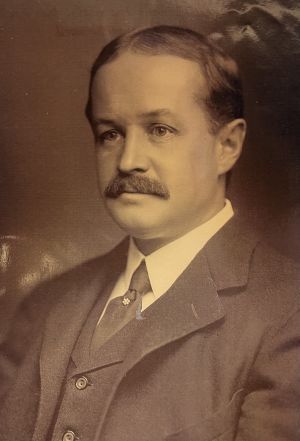
Thayer’s wife, Marian Longstreth Morris Thayer, and son, John “Jack” Borland Thayer III (Jr.), survived the tragedy and created the collection. In 2014, the collection was gifted to the University of Pennsylvania's Kislak Center for Special Collections, Rare Books and Manuscripts by Jack Thayer's daughter, Pauline Thayer Maguire, and her husband, Robert Maguire.
History

The Thayers were a prominent and wealthy family in the Philadelphia area at the turn of the 19th century. John Borland Thayer Sr. (1862-1912) was born in Philadelphia and attended the University of Pennsylvania. He was the Second Vice President of the Pennsylvania Railroad Company at the time of his death. He lived in Haverford, Pennsylvania with his wife, Marian Thayer, (1872-1944) and their four children: John “Jack” Borland Thayer Jr. (1894-1945), Frederick Morris Thayer (1896-1956), Margaret Thayer (1898-1960), and Pauline Thayer (1901-1981). In 1912, John, Marion, and Jack traveled to Europe and boarded the RMS Titanic for their return to the United States.

On the night of April 14, 1912, the Titanic disaster began. Separated from her husband and son by a large crowd, Marian boarded lifeboat 4. As the ship began to sink, 17-year-old Jack stood by the rail with passenger Milton Long, who he’d just met, said goodbye, and jumped feet first just before it split in half. He was pulled underwater by the suction of the sinking vessel, but found refuge on an overturned lifeboat and was eventually rescued by lifeboat 12. He was reunited with his mother on the RMS Carpathia. His father's body was never recovered. [1]
Four years later, Jack graduated from the University of Pennsylvania, served as a captain in the United States Army in World War I, and began his career in banking. He married Lois Buchanan Cassatt in 1917 and had six children: Edward and John (who both enlisted in the armed forces during World War II), Lois, Julie, Pauline, and Alexander, who died a few days after his birth. Jack served as treasurer and, later, financial vice-president for the University of Pennsylvania from 1939 until his death by suicide in 1945 at the age of 50. Contributions to the depression Jack suffered from later in life were the deaths of his son, Edward, and mother, Marian. A bomber pilot during the war, Edward’s plane was shot down in 1943 and his body was never found. Marion died at her home in Haverford on April 14, 1944, the 32nd anniversary of the Titanic disaster, at the age of 72.
As a reader and researcher of the Thayer family’s history and memorial collection, I have adopted Astrid Rasch’s proposed strategy of anxious reading that subjects texts, specifically memoirs, to “critical scrutiny despite, and alongside, the empathy that we feel for our subjects…This entails acknowledging both the pain that the author has gone through and the traumatic experience of those represented, and at the same time examining the way in which that trauma is described and how it functions in the moral and political economy of the text in its context." [2] This subscription to anxious reading has allowed me to sympathetically engage with this memorial collection and the Thayer family who, as victims of a random and cruel trauma, have continued to bear witness to extreme suffering, grief, and loss since 1912. As Jack recalls in an article for the Philadelphia Evening Bulletin in 1932, "the spectacle of nearly 1,500 people struggling in the ice-cold waters of the Atlantic, and the steady roar of their voices, which kept up for 15 or 20 minutes, is a memory that does not become dim, even after 20 years." [3]
Alongside this sympathetic reading is a critical examination of the collection. Because the collection is largely composed of first-hand accounts of the traumatic sinking, I initially had some hesitancy about their accuracy. However, a 2003 study that evaluated the accuracy of archival eyewitness testimony from survivors of the Titanic disaster who witnessed the ship's final plunge indicates that most of the testimonies (15 eyewitnesses of 20) are consistent with forensic evidence that demonstrates that the Titanic was breaking apart while it was still on the ocean's surface.[4] This supports the idea that the contents of this collection are probably correct and reliable retellings of what actually happened the night of the shipwreck. However accurate their testimonies are, it is still important to evaluate the Thayer family’s socioeconomic positions at the time of the sinking and beyond. As white Americans, aristocrats, and first-class survivors with ties to powerful institutions in the Philadelphia area, the Thayers had access to the technology, capital, and publishing resources that allowed for the creation, protection, and century-long maintenance of this extensive and historically valuable collection. Instead of ignoring the traumatic impact of the violence of the Titanic disaster on the Thayer family, I aim to follow Rasch and use this impact as a “point of departure that allows us to study not violence itself, but our own empathetic response to the traumatized victim, and to ask how such a response focuses our attention on some victims over others."[2] While focusing on the Thayers, I wish to keep in mind other victims and survivors who might not have had the socioeconomic means to maintain a memorial collection like the Thayers’, or whose voices have otherwise been drowned out by time and/or circumstance.
Content
I. First-hand accounts of the sinking of the Titanic
- Folder 1: Gracie, Archibald, letter to John Hagan regarding statements made by Hagan; also includes responses by Gracie clarifying events surrounding the sinking of Titanic (3 copies), 1912 September 26.
- Folder 2: Stephenson, Martha Eustis, and Elizabeth Mussey Eustis, "The Titanic: Our Story", undated.
- Folder 3: Thayer, John B., account of the sinking dictated by Thayer and published in newspapers across the United States, 1912 April 21-26.
- Folders 4-5: Thayer, John B., "Sinking of Titanic," written for the Philadelphia Evening Bulletin (includes original ribbon typescript and published newspaper article), 1932.
- Folders 6-9: Thayer, John B., Sinking of the S.S. Titanic, (includes original carbon typescript, original ribbon typescript, galley proofs [1 clean and 1 corrected copy], and Library of Congress certificate of copyright registration), 1940.
II. Thayer family material
- Folder 10: Thayer, John B. (1862-1912), newspaper clippings and order of services at the Church of the Redeemer, paying tribute to, 1912 April 23-27, 1914 June 25.
- Folder 11: Thayer, John B. (1862-1912), photographic prints and biographical sketch, before 1912, 1999.
- Folder 12: Thayer, John B. (1894-1945), photographic prints and biographical sketch, circa 1912-1917, 1999.
- Folder 13: Thayer, Lois Cassatt (wife of John B. Thayer (1894-1945), letter from Robert Morris regarding Marian Longstreth Morris Thayer's death in 1944, 1974 August 13.
- Folders 14-16: Thayer, Marian Longstreth Morris, letters from, photograph of, and silver-plated framed verse endorsed by Bruce Ismay, 1912-1913.
- Folder 17: Thayer, Marian Longstreth Morris, photographic prints and biographical sketch, before 1912, 1999.
III. Efforts to memorialize the sinking of the Titanic
- Folder 18: Academy Chicago Publishers, correspondence with Richard Fremont-Smith and Pauline Thayer Maguire regarding re-publishing The Sinking of the S.S. Titanic, by John B. Thayer, 1997-2006.
- Folder 19: Baldwin, Hanson, story entitled, "R.M.S. Titanic," possibly published in Harpers Monthly Magazine, 1932.
- Folder 20: Lists of and articles about artifacts, books, and collections relating to Titanic, 1985-2012.
- Folder 21: Lord, Walter, letters to Robert Maguire regarding Life Boat 1, 1983 July-September.
- Folder 22: Maguire, Pauline Thayer, letters to Vermont senators and representatives regarding the "RMS Titanic Maritime Memorial Preservation Act of 2006", 2007 April 14.
- Folder 23: Newspaper clippings regarding the sinking of Titanic and its aftermath, 1912 April 16-17, June 1.
- Folder 24: Newspaper clippings regarding and obituaries for Titanic survivors, 1996-2007, undated.
- Folder 25: Thornwillow Press, letters from Luke Ives Pontifell to Robert Maguire regarding special limited edition of The Sinking of the S.S. Titanic, by John B. Thayer, 2012.
- Folder 26: Wallace, Merie Weismiller, letters to Robert and Pauline Maguire regarding James Cameron's film, Titanic, 1996.
- Folder 27: Wilson, Frances, correspondence to Robert Maguire regarding Wilson's writings on Titanic and Bruce Ismay, 2012.
Notable Items
Newspaper Scrapbook of Jack Thayer's Testimony
In Folder 3 of the collection are unbound scrapbook pages that feature newspaper clippings containing a survivor’s account of the sinking of the Titanic, dictated by Jack Thayer and published in 57 different newspapers across the nation, including the Baltimore Sun, Washington Post, and Chicago Tribune. Accompanying each pasted clipping are handwritten captions, identifying the newspaper’s name and date of publication. Prior to their arrival at the Kislak Center and their organization into folders, the scrapbook pages were probably bound together in a binder or metal ring, as evidenced by a hole punched on the top, left corner of each sheet of paper. The clippings do show some evidence of readership in the form of folded ends and the underlining of keywords like “Pennsylvania”. It is unclear how the Thayer family obtained these clippings, as many of them originated and were meant to circulate in states outside of and far from Pennsylvania, such as Iowa and Louisiana. Whether they were obtained through interstate travel or mail correspondence, it is important to note that the collection and successful preservation of so many different and far-reaching clippings is no small feat.
The printed narrative is consistent across all 57 publications. The structure, diction, and tone are nearly identical in every clipping, documenting important moments in Jack’s experience of the night, including when he rose from bed and dressed in his overcoat to unassumingly boarded the ship’s deck with his parents, and when he sang hymns and prayed with other survivors aboard his lifeboat as they waited to be rescued by the Carpathia. It is doubtful that a surveyor of this scrapbook would want to read the same story, however harrowing and thrilling it may be, 57 separate times. What one takes away from this collection of clippings is the large, nationwide reach and voluminous dissemination of Jack’s singular testimony. Quantity, not quality, seems to be of importance in this folder. This aligns with James Mussell’s analysis of Victorian print culture which had taken a stronghold in Europe and the United States at the time of the sinking in 1912. Defined by technological and industrial advancements, the multifaceted inscription of increasingly affordable, portable, and flexible paper material, and the stabilization of the writing space,[5] Victorian print culture complemented existing forms of the persistence of information (such as monumental statues and buildings), altered the ways information existed at the time, and offered a form of persistence based on circulation: “Rather than endure through the persistence of monuments, the logic of print is to endure through multiplication and dissemination”.[5] The prominent public presence of Jack’s testimony, based on its duplication and nationwide circulation, is clearly displayed in this scrapbook. This presence, coupled with the insubstantiality[5] and ephemerality of the scrapbook’s flimsy news clippings and unprotected pages, showcases the Thayers’ value of movement and reach as they utilized Victorian print culture as a tool of remembrance and persistence. The deliberate and careful preservation of news clippings by the Thayer family has transformed them from functional[6], destined-to-be-forgotten, "multifaceted agents within culture to stand, instead, as ideal representatives"[6] that persist when actual memory does not[5], and relays their relation to the past as victims of tragedy.[6]
-
Columbus Dispatch - April 21, 1912
-
New York City World - April 21, 1912
-
Baltimore Sun - April 21, 1912
-
Davenport Democrat & Sioux City Journal - April 21-24, 1912
-
Titusville Herald - April 24, 1912
-
Memphis Commercial Appeal & Nashville Tennessean - April 21, 1912
-
Washington Post - April 21, 1912
-
New York City Tribune - April 21, 1912
-
Newark Sunday Call - April 21, 1912
The Sinking of the S.S. Titanic, April 14-15, 1912
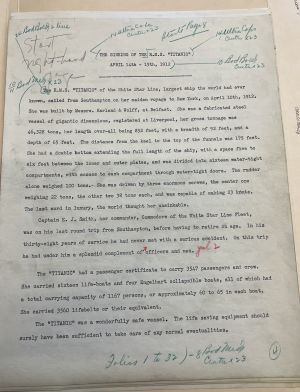

In Folders 6-9 are the various versions of Jack Thayer’s memoir, Sinking of the S.S. Titanic, including the original carbon typescript, original ribbon typescript, and galley proofs [1 clean and 1 corrected copy] that paved the way for its private publishing in 1940. Also in the folder is a Library of Congress certificate of copyright registration. In contrast to the wide reach achieved by Jack’s testimony to the press in 1912 (as seen in Folder 3), his revisitation of the tragedy 28 years later in the form of a memoir was "written primarily as a family record for the information of [his] children and perhaps their children in memory of [his] father, John Borland Thayer, the third of that name, who lost his life in the disaster," [7]
The multiple preliminary versions and drafts of the memoir featured in these folders, as well as the significant amount of corrective marginalia, indicate that they were read, proofread, agonized over, and finally perfected to produce a thoughtful and literary organization of Jack’s intimate thoughts, feelings, and memories of the disaster and its aftermath. In one of the more gripping sections of the memoir, Jack “merges self and world in a metaphorical manner” and characterizes the Titanic disaster as the “20th century’s wake-up call”, ‘It seems to me that the disaster about to occur was the event, which not only made the world rub its eyes and awake, but woke it with a start, keeping it moving at a rapidly accelerating pace ever since, with less and less peace, satisfaction, and happiness.’ [8] As Peter Middleton and Tim Woods describe, “Disaster made him aware that the self is a ‘Being-towards-the end’...a self whose awareness of its own inevitable mortal ending helps constitute its sense of the world.[8]
In this instance of persistence and remembrance, we see a victim of tragedy become an agent and authority of his own history. The creation, organization, and perfection of Jack’s memoir was certainly a labor of love meant to inform his immediate family of his own experiences and perspective and honor his late father’s legacy. The memoir’s private publishing and copyright registration are suggestive of Jack's protective authorship and ownership of ideas and a desire for officiality and federal recognition. It is also worth noting that the memoir was produced at an institution that Jack had close ties to—his place of work, the University of Pennsylvania.
Letter regarding James Cameron's Titanic


In Folder 26 are two letters from Merie Weismiller Wallace, a Los Angeles-based unit still photographer, to Pauline Thayer Maguire and her husband, Robert regarding the production of James Cameron’s 1997 film Titanic. The first letter, dated August 5, 1996, is a printed word document from Wallace requesting access to a “steerage class servant account which was never published”[9] and which the Maguires had a copy of. There are several instances of handwriting and annotation including Wallace’s signature at the end of the letter, a series of numbers, the phrase “James Cameron Titanic”, and the highlighting of Cameron’s name and a sentence establishing a response deadline from the Maguires which suggests that the letter was used as a reminder to respond. The second letter, dated September 17, is a note of appreciation, handwritten on a monogrammed card, from Wallace to Robert Maguire thanking him for providing access to the servant account, “Jim was pleased to read it, as it contained details which he perceived as speculation previously – such as the sound and water in steerage class". [9] Wallace also writes about how amazing the project is, “...to see ½ of the Titanic being built in an outdoor water tank is incredible. The interior sets are so opulent – as is the wardrobe.”
These letters are instances of remembrance and semi-historical accounts of the Titanic disaster that were made by people—in this case, filmmakers like Cameron and Wallace—who did not experience it. Middleton and Woods make a compelling argument for the renewed interest in the Titanic and its victims that spiked in the late 20th century and resulted in an expensive, widely popular, and romanticized retelling of the ship’s history, like Cameron’s 1997 major motion picture. They argue that footage of the recent 1985 discovery of the shipwreck (acquired by oceanographers Robert Ballard and Louis-Michel) coupled with cultural practices of memory, “especially oral recall, keepsakes, and photographs” [10] function in the Titanic film to “make the lost world of the ship’s history perceptible again.” [10] “The collaboration of the search technology and the survivor’s memory, focused on this site of memory, at last makes it possible to travel back in time with the camera and witness the whole of the final voyage and its immediate aftermath.” [10] We see this sentiment at work in Wallace’s letters to the Maguires. They exhibit Cameron’s desire to re-create a relatively authentic and accurate re-telling of the tragedy by drawing on and incorporating a servant’s first-hand account of the sinking and utilizing industry, technology, and artistry—better known as movie magic—in his remembrance project.
Legacy
The John B. Thayer memorial collection of the Sinking of the Titanic is a moving tribute to those who lost their lives in the 1912 disaster, including John Thayer Sr. It is an intimate look into the Thayer family's selective acts of remembrance of the tragedy, their survival, and the many lives they led until 2012. It is also a fascinating and useful century-old historical body that documents the progression and evolution of social and cultural memory of trauma as it relates to the Titanic tragedy. Beginning with a newspaper scrapbook of Jack Thayer's 1912 survivor's testimony, the collection grows, as time passes, and manifests more official and authoritative efforts to memorialize the tragedy, including Jack’s privately published 1940 memoir and documentation of James Cameron’s efforts to authenticate his 1997 film by consulting Thayer family records. The study of the collection as a whole, but especially of these notable items, showcases how the Thayer family’s efforts to memorialize their patriarch, recount their trauma, and keep the Thayer legacy alive have evolved over time.
References
- ↑ John B. Thayer memorial collection of the Sinking of the Titanic, Kislak Center for Special Collections, Rare Books and Manuscripts, University of Pennsylvania, box 1, folder 3.
- ↑ 2.0 2.1 Rasch, Astrid. "Anxious Reading: Interrogating Selective Empathy in Trauma Memoirs." Auto/biography Studies, 2021, p.5
- ↑ John B. Thayer memorial collection of the Sinking of the Titanic, Kislak Center for Special Collections, Rare Books and Manuscripts, University of Pennsylvania, box 1, folder 4
- ↑ Riniolo, T. C., Koledin, M., Drakulic, G. M., & Payne, R. A. An archival study of eyewitness memory of the titanic's final plunge. The Journal of General Psychology, 130(1), 2003. 89-95. Retrieved from https://proxy.library.upenn.edu/login?url=https://www.proquest.com/scholarly-journals/archival-study-eyewitness-memory-titanics-final/docview/213652240/se-2?accountid=14707
- ↑ 5.0 5.1 5.2 5.3 Mussell, James. "THE PASSING OF PRINT: Digitising Ephemera and the Ephemerality of the Digital." Media History, vol. 18, no. 1, 2012. pp. 81-2
- ↑ 6.0 6.1 6.2 Mussell, James. "THE PASSING OF PRINT: Digitising Ephemera and the Ephemerality of the Digital." Media History, vol. 18, no. 1, 2012. p. 80
- ↑ John B. Thayer memorial collection of the Sinking of the Titanic, Kislak Center for Special Collections, Rare Books and Manuscripts, University of Pennsylvania, box 1, folder 6
- ↑ 8.0 8.1 Peter Middleton & Tim Woods. “Textual memory: The making of the Titanic's literary archive.” Textual Practice, 15:3, 2001, 518-19. DOI: 10.1080/09502360110070420
- ↑ 9.0 9.1 John B. Thayer memorial collection of the Sinking of the Titanic, Kislak Center for Special Collections, Rare Books and Manuscripts, University of Pennsylvania, box 1, folder 26.
- ↑ 10.0 10.1 10.2 Peter Middleton & Tim Woods. “Textual memory: The making of the Titanic's literary archive.” Textual Practice, 15:3, 2001, 507-08. DOI: 10.1080/09502360110070420
